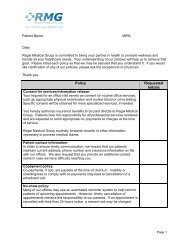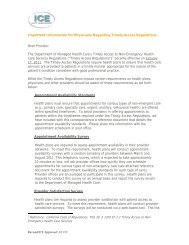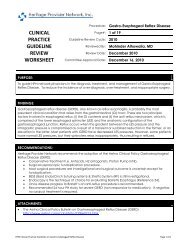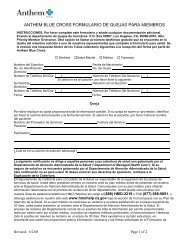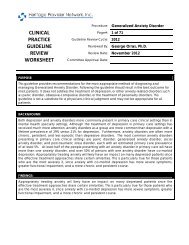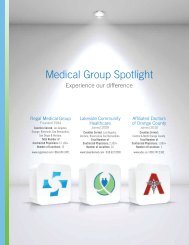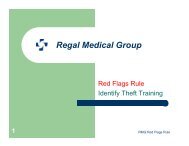Guide to Clinical Preventive Services 2012 - Agency for Healthcare ...
Guide to Clinical Preventive Services 2012 - Agency for Healthcare ...
Guide to Clinical Preventive Services 2012 - Agency for Healthcare ...
You also want an ePaper? Increase the reach of your titles
YUMPU automatically turns print PDFs into web optimized ePapers that Google loves.
SCREENING FOR BLADDER CANCERCLINICAL SUMMARY OF U.S. PREVENTIVE SERVICES TASK FORCE RECOMMENDATIONPopulation Asymp<strong>to</strong>matic adultsRecommendationNo recommendation.Grade: I (Insufficient Evidence)Risk fac<strong>to</strong>rs <strong>for</strong> bladder cancer include:Risk Assessment● ● Smoking● Occupational exposure <strong>to</strong> carcinogens (e.g., rubber, chemical, and leather industries)● Male sex● Older age● White race● Infections caused by certain bladder parasites● Family or personal his<strong>to</strong>ry of bladder cancerScreening tests <strong>for</strong> bladder cancer include:Screening Tests● Microscopic urinalysis <strong>for</strong> hematuria● Urine cy<strong>to</strong>logy● Urine biomarkersInterventionsThe principal treatment <strong>for</strong> superficial bladder cancer is transurethral resection of the bladder tumor, which may be combined with adjuvantradiation therapy, chemotherapy, biologic therapies, or pho<strong>to</strong>dynamic therapies.Radical cystec<strong>to</strong>my, often with adjuvant chemotherapy, is used in cases of surgically resectable invasive bladder cancer.Balance of Benefits and HarmsThere is inadequate evidence that treatment of screen-detected bladder cancer leads <strong>to</strong> improved morbidity or mortality.There is inadequate evidence on harms of screening <strong>for</strong> bladder cancer.In deciding whether <strong>to</strong> screen <strong>for</strong> bladder cancer, clinicians should consider the following:Suggestions <strong>for</strong> Practice● ● Potential preventable burden: early detection of tumors with malignant potential could have an important impact on the mortality rate ofbladder cancer.● ● Potential harms: false-positive results may lead <strong>to</strong> anxiety and unneeded evaluations, diagnostic-related harms from cys<strong>to</strong>scopy andbiopsy, harms from labeling and unnecessary treatments, and overdiagnosis.● ● Current practice: screening tests used in primary practice include microscopic urinalysis <strong>for</strong> hematuria and urine cy<strong>to</strong>logy; urinebiomarkers are not commonly used in part because of cost. Patients with positive findings are typically referred <strong>to</strong> a urologist <strong>for</strong> furtherevaluation.Other Relevant USPSTFRecommendationsRecommendations on screening <strong>for</strong> other types of cancer can be found at www.uspreventiveservicestask<strong>for</strong>ce.org.For a summary of the evidence systematically reviewed in making these recommendations, the full recommendation statement, and supporting documents, please go <strong>to</strong>http://www.uspreventiveservicestask<strong>for</strong>ce.org.●●●●●●●●●13






